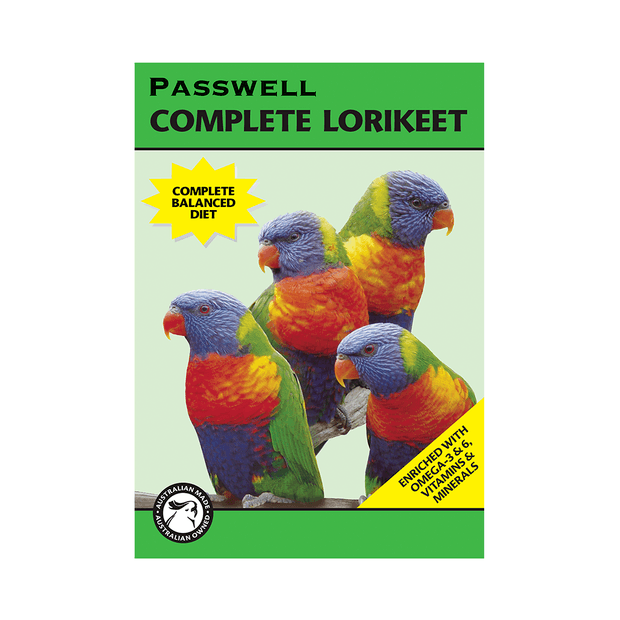Passwell Complete Lorikeet 1kg
Price range: $19.00 through $109.00
Passwell Complete Lorikeet
is a nutritionally balanced, maintenance diet for lorikeets & lories.
- Description
- Additional information
- Ingredients
- Nutritional Analysis
- Feeding Directions
- Feeding Guide
- Reviews (0)
Key Features
- Specifically formulated to provide lorikeets with all known essential nutrients,vitamins and minerals.
- Calorie-controlled feed guidelines to help weight control.
- Balanced protein content to maintain good feather and body condition.
- Moderate iron and vitamin A levels to minimise the risk of excessive iron storage.
Additional information
| Weight | 1 kg |
|---|---|
| Size | 1kg, 5kg, 10kg |
Ingredients
Ingredients
Ground cereals, sucrose, whey and soy proteins, dextrose, mannan oligosaccharides, β-glucans, lysine, methionine, vegetable oils, omega-3 and omega-6 fatty acids (including EPA & DHA), carotenoids, vitamins A, B1,B2,B6, B12,C,D3,E,K, nicotinamide, pantothenic acid, biotin, folic acid, choline, inositol, calcium, phosphorus, potassium, sodium, magnesium, zinc, iron, manganese, copper, iodine, selenium
Nutritional Analysis
Analysis
| Protein (min) | 13% |
| Fat (min) | 6% |
| Carbohydrate (min) | 72% |
| Fibre (max) | 3% |
| Calcium | 0.7% |
| Iron | 40mg/kg |
| Vitamin A | 0.3mg/kg |
| Metabolisable Energy (ME) | 16 MJ/kg |
Feeding Directions
Directions
Passwell Complete Lorikeet is a completely balanced maintenance food and may represent upto 80% of a lorikeet’s diet. The remainder of the diet should be made up of a variety of fresh fruits & vegetables and as much native blossom as possible.
Feed Complete Lorikeet dry (recommended), or mix with warm water to a desired consistency. Note that the addition of water will increase the rate of spoilage by micro-organisms.
Remove soiled or uneaten food daily and replace with fresh food. Some lorikeets will load their drinking water with dry food so always ensure that fresh water is available.
Feeding Guide
Feeding Guide
Caged birds tend to over-eat and become obese when offered an unlimited supply of food. It is a healthier, and more economical practice to establish your birds’ daily food requirement and feed that amount.
| Species | Complete Lorikeet powder food per day (1 level teaspoon = 3g approx.) |
|
| grams | Level teaspoons |
|
| Little & Purple-crowned Lorikeet | 9 | 3 |
| Musk & Scaly-breasted Lorikeet | 12 | 4 |
| Rainbow & Red-collared Lorikeet | 15 | 5 |
| Red & Dusky Lory | 15 | 5 |
| Chattering & Black-capped Lory | 24 | 8 |
Note that these feeding estimates are for non-breeding birds and can vary depending on the nutritional value of other foods eaten, as well as lorikeet activity levels and daily temperature.


Reviews
There are no reviews yet.